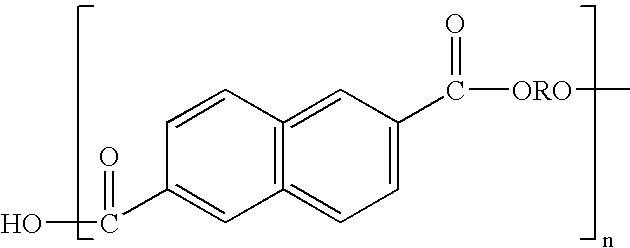Aqueous polymer dispersions
a technology of aqueous polymer and dispersions, applied in the field of aqueous polymer dispersions, can solve the problems of poor hydrolytic stability, large amount of volatile amines and solvents, and inability to meet water resistance, and achieve good wet adhesion, good hydrolytic stability, and good gloss.
- Summary
- Abstract
- Description
- Claims
- Application Information
AI Technical Summary
Benefits of technology
Problems solved by technology
Method used
Image
Examples
example i
Preparation of Low Acid Value Base Polymer—Acidolysis of PET
[0081]A 3 liter, 4-necked round bottom flask equipped with inert gas, mechanical stirrer, Barrett tube and Friedrich's condenser is charged with 423 grams of polyethylene terephthalate, 822 grams of soya fatty acid, 3.3 grams of dibutyl tin oxide catalyst, and 133 grams of isophthalic acid. The contents are heated to 490° F. and held until all contents had melted. The solution is cooled to 325° F. and 206 grams of trimethylolethane is added. The contents are heated to 460° F. and held for an acid value of less than 12. Once reached, heat is removed and the contents allowed to cool. The final resin product had an NVM of 97.9, viscosity of 12,200 cps (using Brookfield LVT#3 at 25 C., 12 rpm), acid value of 6.5, Mw of 3619, Mn of 1639 and Pd of 2.20.
example ii
Preparation of Low Acid Value Base Polymer—Acidolysis of PET
[0082]A 3 liter, 4-necked round bottom flask equipped with inert gas, mechanical stirrer, Barrett tube and Friedrich's condenser is charged with 764.72 grams of polyethylene terephthalate, 1124.42 grams of tall oil fatty acid, 9.5 grams of dibutyl tin oxide catalyst. The contents are heated to 490° F. and held until all contents have melted and a clear solution is obtained. The solution is cooled to 325° F. and 301.62 grams of trimethylolethane is added. The contents are heated to 465° F. and held for an acid value of less than 10. Once reached, heat is removed and the contents allowed to cool. The final base polymer resin product has an NVM of 98.3, viscosity of 11,200 cps (using Brookfield LVT#3, 12 rpm), acid value of 6.6, Mz of 4464, Mw of 2522, Mn of 1418 and Pd of 1.78.
example iii
Direct Monomer Modification
[0083]511 grams of the resin of Example I and 13 grams of propylene glycol monobutyl ether are charged in a reaction vessel and heated to about 138° C. Added to the vessel over a 3.5 hour period is 333.3 grams of methyl methacrylate, 30.2 grams of acrylic acid, and 109.6 grams of ethyl hexyl acrylate. A second feed of 5.7 grams of t-butyl perbenzoate (2.5% in propylene glycol monobutyl ether) is added over the same time period. Upon complete addition of both feeds, a chase of 5.6 grams t-butyl perbenzoate in 10 grams of propylene glycol monobutyl ether is added over a 1.5 hour time period. Heat is held at 138° C. for one hour. The final monomer-modified polymer had an acid value of 29.
PUM
| Property | Measurement | Unit |
|---|---|---|
| weight % | aaaaa | aaaaa |
| temperatures | aaaaa | aaaaa |
| temperature | aaaaa | aaaaa |
Abstract
Description
Claims
Application Information
 Login to View More
Login to View More - R&D
- Intellectual Property
- Life Sciences
- Materials
- Tech Scout
- Unparalleled Data Quality
- Higher Quality Content
- 60% Fewer Hallucinations
Browse by: Latest US Patents, China's latest patents, Technical Efficacy Thesaurus, Application Domain, Technology Topic, Popular Technical Reports.
© 2025 PatSnap. All rights reserved.Legal|Privacy policy|Modern Slavery Act Transparency Statement|Sitemap|About US| Contact US: help@patsnap.com


